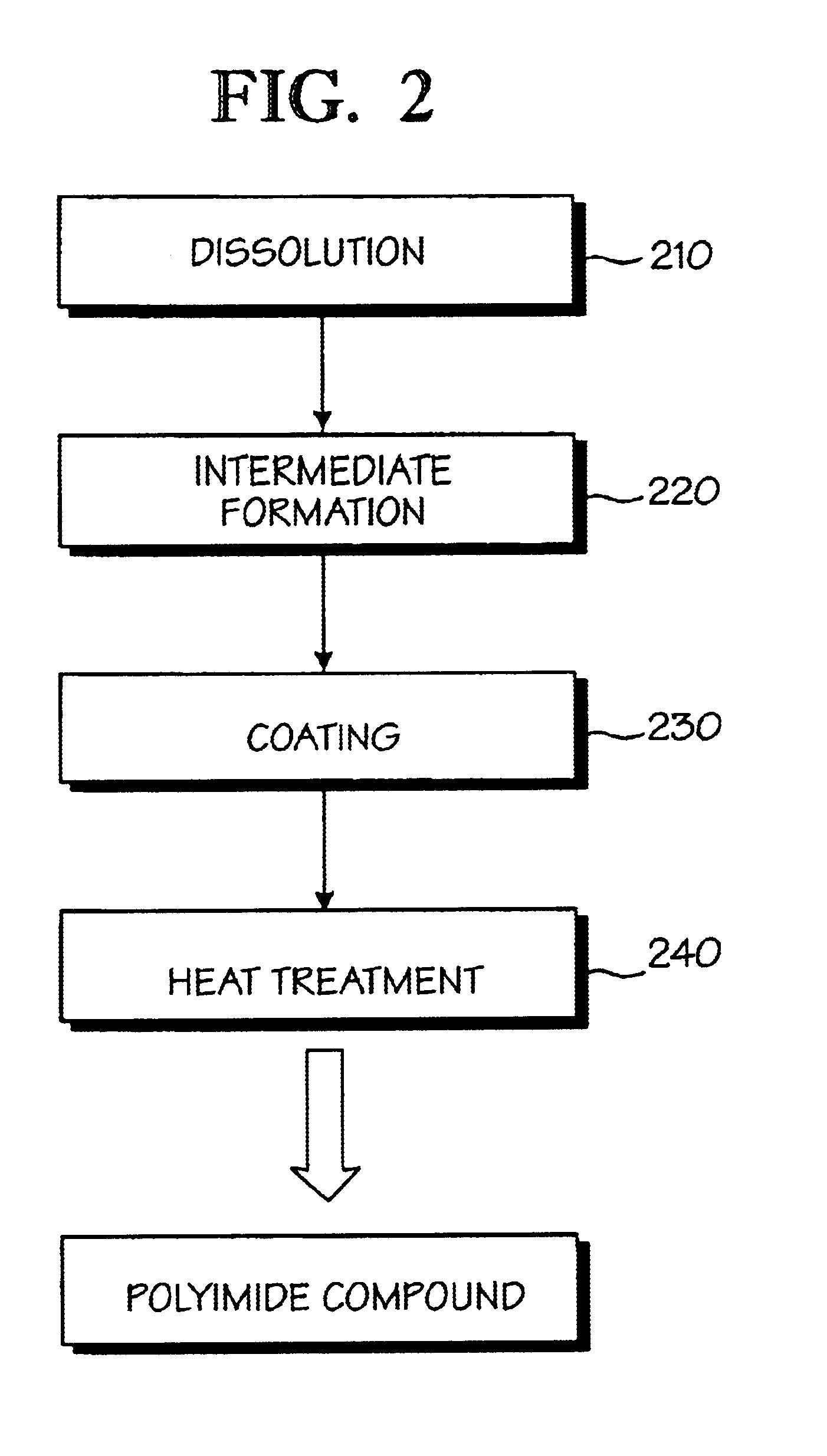Optical polyimide precursor, optical polyimide compound and fabricating method thereof
a technology of optical polyimide and precursor, which is applied in the preparation of amino compounds, diaryl/triaryl methane dyes, instruments, etc., can solve the problems of harmonic overtones at high frequencies, inorganic crystals have a limitation in mass production, and absorption loss
- Summary
- Abstract
- Description
- Claims
- Application Information
AI Technical Summary
Benefits of technology
Problems solved by technology
Method used
Image
Examples
embodiment 1-1
[0043]2,2-bis(4-hydroxyphenyl)-1,1,1,3,3,3-hexafluoropropane(5.1 g, 0.0152 mol) and 2-chloro-5-nitrobenzotrifluoride (7.518 g, 0.0333 mol) were dissolved in 63 ml of N,N-dimethylacetamide (with about 20% solid content). To the reaction mixture were added 6.91 g of potassium carbonate (0.05 mol), 0.0975 g of tert-butyl ammonium chloride and 0.195 g of copper powder, after which the mixture was heated at 100° C. for 2 hours and filtered to remove copper. The filtrate was then added to a mixed solvent of methanol and water (1:1), resulting in precipitation. Recrystallization from acetic acid gave dinitro-compound as yellow crystals (8.497 g, 78.5% yield). 5.0 g of this compound was dissolved in tetrahydrofuran and reduced using palladium (10% in activated carbon) as a catalyst under hydrogen atmosphere, to obtain a diamine compound defined by the formula 1 (2.633 g, 60.0% yield).
embodiment 1-2
[0044]Tetrafluoro-1,4-hydroquinone (2.761 g, 0.0152 mol) and 2-chloro-5nitrobenzotrifluoride (7.518 g, 0.0333 mol) were dissolved in 51 ml of N,N-dimethylacetamide (with about 20% solid content). To the reaction mixture were added 6.91 g of potassium carbonate (0.05 mol), 0.0975 g of tert-butyl ammonium chloride and 0.195 g of copper powder, after which the mixture was heated at 110° C. for 16 hours and filtered to remove copper. The filtrate was then added to a mixed solvent of methanol and water (1:1), resulting in precipitation. Recrystallization from acetic acid gave dinitro-compound as flesh-colored crystals (5.505 g, 64.8% yield). 5.0 g of this compound was dissolved in tetrahydrofuran and reduced using palladium (10% in activated carbon) as a catalyst under hydrogen atmosphere, to obtain a diamine compound defined by the formula 1 (3.407 g, 76.3% yield).
embodiment 1-3
[0045]Tetrachloro-1,4-hydroquinone (3.768 g, 0.0152 mol) and 2-chloro-5nitrobenzotrifluoride 7.518 0.0333 mol) were dissolved in 56 ml of N,N-dimethylacetamide (with about 20% solid content). To the reaction mixture were added 6.91 g of potassium carbonate (0.05 mol), 0.0975 g of tert-butyl ammonium chloride and 0.1958 of copper powder, after which the mixture was heated at 80° C. for 24 hours and filtered to remove copper. The filtrate was then added to concentrated sulfuric acid, resulting in precipitation. Recrystallization from acetic acid gave dinitro-compound as yellow crystals (5.90 g, 62.0% yield). 5.0 g of this compound was dissolved in terrahydrofuran and reduced using palladium (10% in activated carbon) as a catalyst under hydrogen atmosphere, to obtain a diamine compound defined by the formula 1 (3.148 g, 69.6% yield).
PUM
| Property | Measurement | Unit |
|---|---|---|
| Optical properties | aaaaa | aaaaa |
Abstract
Description
Claims
Application Information
 Login to View More
Login to View More - R&D
- Intellectual Property
- Life Sciences
- Materials
- Tech Scout
- Unparalleled Data Quality
- Higher Quality Content
- 60% Fewer Hallucinations
Browse by: Latest US Patents, China's latest patents, Technical Efficacy Thesaurus, Application Domain, Technology Topic, Popular Technical Reports.
© 2025 PatSnap. All rights reserved.Legal|Privacy policy|Modern Slavery Act Transparency Statement|Sitemap|About US| Contact US: help@patsnap.com



